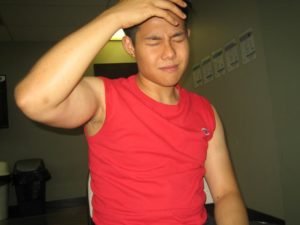Sinus headaches can develop due to inflammation or infection of the mucous membranes that result to pain, congestion and swelling in the sinus cavity. The presence of mucous or air that ends up trapped inside the congested sinuses can trigger a headache.
In most cases, the pain generally starts behind the eyes but can spread into the head and down to the teeth. The triggers for sinus headaches include smoke exposure, allergies, mold and dust. The inflammation should subside first in order to allow the sinuses to drain to provide relief to the headache.
Measures to relieve sinus headaches

- A doctor should be consulted particularly in cases in which the sinus headache is complemented by fever. When it comes to a severe sinus headache that persists for 7 days or more, it might point to a sinus infection that entails antibiotic therapy.
- Alternate the application of warm and cold compresses to stimulate the flow of blood as well as promote drainage of the sinuses. You can prepare a washcloth with hot water and another one with cold water and wring out the excess. Place the warm washcloth over the sinus area for about 3 minutes. Remove it and place the cold washcloth for about 1 minute. Repeat each for 3 times and must be done at least 4 times throughout the day.
- Irrigation of the nasal passages helps clear up any irritants, mucous, bacteria and other particles that can trigger allergic reactions. Cleansing of the sinuses can reduce the swelling and inflammation of the passage membranes as well as promote sinus drainage. For this purpose, a neti pot is utilized and readily available in pharmacies or health food stores. The cleansing solution is comprised of ½ teaspoon non-iodized salt such as sea salt to a neti pot filled with lukewarm distilled water.
- The individual can breathe in moist air from a vaporizer, humidifier or a bowl of steaming water to relieve the sinus headache. It is important to note that dry air worsens the sinus congestion and inflammation while moist air reverses the effect. If a humidifier or vaporizer is not available, you can utilize boiled water in a bowl and then drape a towel over the head and instruct him/her to breathe in the steam by breathing via the nose.
- Encourage the individual to drink water to keep the body properly hydrated as well as keeping the nasal passages moist. This will allow them to drain freely. In addition, increasing the fluid intake and hydration can also help minimize the inflammation as well.
- If the individual suffers for a sinus headache, he/she must sleep on a slightly inclined position to keep the nasal passages clear as well as allowing the sinuses to drain. You can add a few cushions or pillows or a bed wedge to raise the sleeping position.
- An over-the-counter pain medication or anti-inflammatory can be given such as ibuprofen or aspirin (if over 16 years old) to relieve the pain. The over-the-counter decongestants and antihistamines can also provide relief. The commonly used antihistamines include loratidine and diphenhydramine. When diphenhydramine is used, it should be taken in the evening since it can cause drowsiness. Antihistamines are often used along with decongestants such as pseudoephedrine and phenylephrine to promote drainage of the sinuses and clear up the nasal passages.
Considerations to bear in mind
A doctor should be consulted if the sinus headache does not seem to respond to these treatment options within 3 days.
The individual should be encouraged to frequently blow his/her nose to keep bacteria as well as excess mucous out of the nasal passages. This can help prevent the start of sinus headaches.
